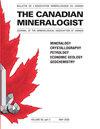Arrheniusite-(Ce), CaMg[(Ce7Y3)Ca5](SiO4)3(Si3B3O18)(AsO4)(BO3)F11, a New Member of the Vicanite Group, from the Östanmossa Mine, Norberg, Sweden
IF 1.5
4区 地球科学
Q3 MINERALOGY
引用次数: 1
Abstract
Arrheniusite-(Ce) is a new mineral (IMA 2019-086) from the Östanmossa mine, one of the Bastnäs-type deposits in the Bergslagen ore region, Sweden. It occurs in a metasomatic F-rich skarn, associated with dolomite, tremolite, talc, magnetite, calcite, pyrite, dollaseite-(Ce), parisite-(Ce), bastnäsite-(Ce), fluorbritholite-(Ce), and gadolinite-(Nd). Arrheniusite-(Ce) forms anhedral, greenish-yellow translucent grains, exceptionally up to 0.8 mm in diameter. It is optically uniaxial (–), with ω = 1.750(5), ε = 1.725(5), and non-pleochroic in thin section. The calculated density is 4.78(1) g/cm3. Arrheniusite-(Ce) is trigonal, space group R3m, with unit-cell parameters a = 10.8082(3) Å, c = 27.5196(9) Å, and V = 2784.07(14) Å3 for Z = 3. The crystal structure was refined from X-ray diffraction data to R1 = 3.85% for 2286 observed reflections [Fo > 4σ(Fo)]. The empirical formula for the fragment used for the structural study, based on EPMA data and results from the structure refinement, is: (Ca0.65As3+0.35)Σ1(Mg0.57Fe2+0.30As5+0.10Al0.03)Σ1[(Ce2.24Nd2.13La0.86Gd0.74Sm0.71Pr0.37)Σ7.05(Y2.76Dy0.26Er0.11Tb0.08Tm0.01Ho0.04Yb0.01)Σ3.27Ca4.14]Σ14.46(SiO4)3[(Si3.26B2.74)Σ6O17.31F0.69][(As5+0.65Si0.22P0.13)Σ1O4](B0.77O3)F11; the ideal formula obtained is CaMg[(Ce7Y3)Ca5](SiO4)3(Si3B3O18)(AsO4)(BO3)F11. Arrheniusite-(Ce) belongs to the vicanite group of minerals and is distinct from other isostructural members mainly by having a Mg-dominant, octahedrally coordinated site (M6); it can be considered a Mg-As analog to hundholmenite-(Y). The threefold coordinated T5 site is partly occupied by B, like in laptevite-(Ce) and vicanite-(Ce). The mineral name honors C.A. Arrhenius (1757–1824), a Swedish officer and chemist, who first discovered gadolinite-(Y) from the famous Ytterby pegmatite quarry.(Ce), CaMg[(Ce7Y3)Ca5](SiO4)3(Si3B3O18)(AsO4)(BO3)F11:瑞典Östanmossa矿维长石组新成员
菱辉石(Ce)是一种新矿物(IMA 2019-086),来自Östanmossa矿山,该矿山是瑞典Bergslagen矿区Bastnäs-type矿床之一。产于交代富氟矽卡岩中,伴生有白云石、透闪石、滑石、磁铁矿、方解石、黄铁矿、白云石-(Ce)、parisite-(Ce)、bastnäsite-(Ce)、萤石-(Ce)、钆辉石-(Nd)。菱铁矿-(Ce)形成一个四面体,绿黄色半透明的颗粒,异常直径可达0.8毫米。它是光学单轴(-),ω = 1.750(5), ε = 1.725(5),在薄片上无多时性。计算密度为4.78(1)g/cm3。Arrheniusite-(Ce)为三角形,空间群R3m,当Z = 3时,单位胞参数a = 10.8082(3) Å, c = 27.5196(9) Å, V = 2784.07(14) Å3。根据x射线衍射数据,对2286次反射[Fo > 4σ(Fo)]的晶体结构进行了细化,得到R1 = 3.85%。基于EPMA数据和结构细化结果,得到用于结构研究的片段的经验公式为:(Ca0.65As3+0.35)Σ1(Mg0.57Fe2+0.30As5+0.10Al0.03)Σ1[(Ce2.24Nd2.13La0.86Gd0.74Sm0.71Pr0.37)Σ7.05(Y2.76Dy0.26Er0.11Tb0.08Tm0.01Ho0.04Yb0.01)Σ3.27Ca4.14]Σ14.46(SiO4)3[(Si3.26B2.74)Σ6O17.31F0.69][(As5+0.65Si0.22P0.13)Σ1O4](B0.77O3)F11;得到的理想配方为CaMg[(Ce7Y3)Ca5](SiO4)3(Si3B3O18)(AsO4)(BO3)F11。辉钼矿(Ce)属于维长石组矿物,与其他同构造成员的区别主要在于其具有以镁为主的八面体配位位点(M6);它可以被认为是一种类似于百霍尔门铁矿-(Y)的Mg-As。三层协调的T5位点部分被B占据,如在钾长石-(Ce)和钙长石-(Ce)中。这种矿物的名字是为了纪念瑞典军官和化学家C.A.阿伦尼乌斯(1757-1824),他首先从著名的伊特比伟晶岩采石场发现了gadolinite-(Y)。
本文章由计算机程序翻译,如有差异,请以英文原文为准。
求助全文
约1分钟内获得全文
求助全文
来源期刊

Canadian Mineralogist
地学-矿物学
CiteScore
2.20
自引率
22.20%
发文量
45
审稿时长
4-8 weeks
期刊介绍:
Since 1962, The Canadian Mineralogist has published papers dealing with all aspects of mineralogy, crystallography, petrology, economic geology, geochemistry, and applied mineralogy.
 求助内容:
求助内容: 应助结果提醒方式:
应助结果提醒方式:


